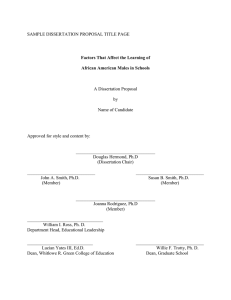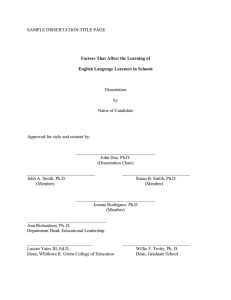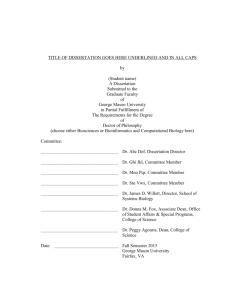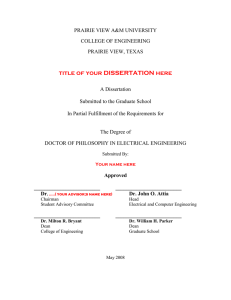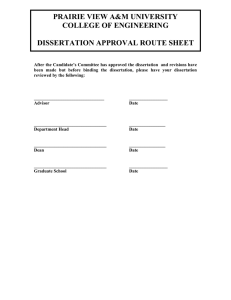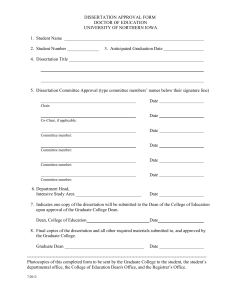SPC Performance Planning and Review (2014)
advertisement
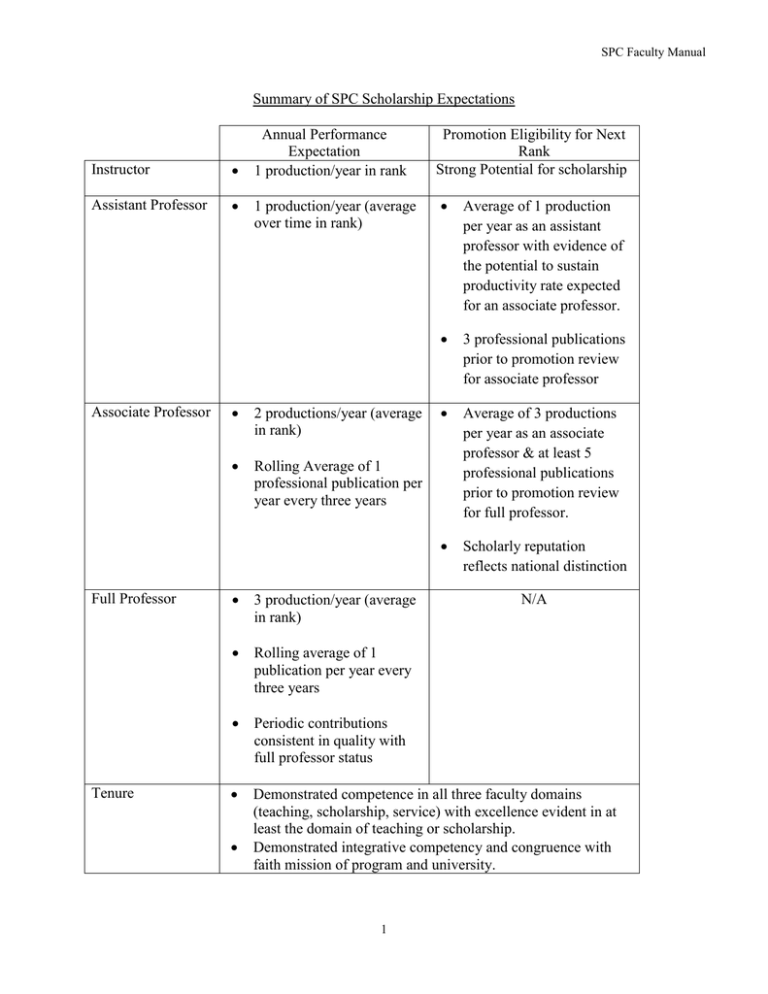
SPC Faculty Manual Summary of SPC Scholarship Expectations Instructor Assistant Professor Associate Professor Full Professor Tenure Annual Performance Expectation 1 production/year in rank 1 production/year (average over time in rank) 2 productions/year (average in rank) Rolling Average of 1 professional publication per year every three years Promotion Eligibility for Next Rank Strong Potential for scholarship Average of 1 production per year as an assistant professor with evidence of the potential to sustain productivity rate expected for an associate professor. 3 professional publications prior to promotion review for associate professor Average of 3 productions per year as an associate professor & at least 5 professional publications prior to promotion review for full professor. Scholarly reputation reflects national distinction 3 production/year (average in rank) Rolling average of 1 publication per year every three years Periodic contributions consistent in quality with full professor status Demonstrated competence in all three faculty domains (teaching, scholarship, service) with excellence evident in at least the domain of teaching or scholarship. Demonstrated integrative competency and congruence with faith mission of program and university. 1 N/A SPC Faculty Manual SPC WORKLOAD POLICY Revised March, 2013 The SPC workload policy clarifies the application and use of the Regent University workload policy found in the Regent Faculty and Academic Policy Handbook. The university policy defines faculty workload as “…all faculty activities that are related to professional duties and responsibilities…distributed across three domains: teaching, scholarship and service.” While faculty members are expected to perform activities in each of these domains, the relative proportion of time spent in each activity may differ based upon missional needs and planned faculty loads. As a general principle faculty loads will be planned in a manner conducive to successful career development when performed well by the faculty member. Examples of specific activities typical of the three traditional faculty work domains are presented in the University handbook. A single workload unit is understood as the amount of work required to prepare and teach a three credit course of average enrollment for the respective discipline. The total expected workload for faculty on a 9 month contract is 10 units and for faculty on a 12 month contract it is 12 units. The Regent and SPC workload policies are intended as a planning tool to allow rational and intentional management of faculty resources, to determine when overload compensation may be appropriate, to facilitate faculty career development, and to ensure that program and university faculty needs are satisfied. The load plan will cover specific tasks and activities assigned to each faculty member. A number of customary duties and roles equally shared by faculty are not specifically addressed in the faculty plan, but remain an expected part of faculty duties. Examples of these customary generic duties include: attendance at chapel, participation in all program/school or university faculty meetings, attending retreats and other in-service activities, and routine academic advising. SPC Workload Guidance by Specific Workload Area Teaching/Mentorship: Teaching workload in the SPC is assigned for three types of activities: course instruction, clinical supervision and dissertation committee service. Course Work Load: A standard three credit, graduate course in psychology or counseling has an average enrollment of 15 students. Yet because of the diverse types of courses in the clinical and counseling programs, class sizes have a relatively broad range. Didactic doctoral courses required for all students in a single cohort will frequently have all students from single cohort enrolled in the course. In this type of course an enrollment of up to 25 students is common and will still be considered a standard course in the discipline with no additional load credit being given for student enrolment. Clinical intensive courses, such as internship or practica, or specialty electives will frequently have smaller enrollments with less than a full cohort registered for each section. Three credit courses of standard enrollments will earn 1 load unit. Because of the need to offer smaller specialty and clinical intensive courses and the added intensive mentorship that occurs in such courses, faculty will receive full work load credit for courses approved by the dean with enrollments as small as 7 students. Courses of other than 3 credit hours will 2 SPC Faculty Manual be assigned work load in proportion to their three credit numerical equivalent. So for example, a 1 credit tutorial with a standard course enrolment for a normal class would result in a .33 work load. Once faculty members have received load credit for teaching a course, they are obligated to perform all duties associated with the course instruction without further load credit or compensation. For example, the grading of work submitted after the term has ended to satisfy an incomplete would be expected without additional load credit or compensation. Load unit adjustments based on deviations from standard enrollment will be made as follows: Graduate Course Work Load Adjustments Based on Enrollment 15 Students 1 Unit <7 Students* -.1 per student >25 students +.1 per every 5 students over 25 (.5 maximum) *Courses with registration < 7 require approval from the dean to be offered. New Course Preparations (.1 units): Faculty assigned to teach a new course they have not previously instructed, but that has already been designed will receive a load increase of .1 work units. New Course Creation/Major Course Redesign (.5 units): Faculty asked to create a new course or to engage in major revision of a previously designed course will receive a load increase of .5 work units. Adjustment for Co-Instructed Courses: Courses with multiple instructors will divide the workload for the course according to each individual instructor’s percentage of the instructional duties. The total proportion of work units across all co-instructors must total to the eligible workload for the course if instructed by a single instructor. Independent Studies: (.033 work units per SCH) Independent studies must be preapproved by the dean to count as part of a planned workload or for overload consideration. Work load for independent studies will be awarded .033 of a unit per each student credit hour generated. Independent studies run as a nested or subunit within a larger course will not receive separate work load consideration. In such cases the SCH enrollment generated from the students enrolled in the independent study will be pooled with the enrollment for the associated course and the combined enrollments will be used to determine the appropriate work load. Work Load Exempt Registrations: Some courses may not be eligible for work load units. For instance, no work units may be taken for student registration on faculty research teams. Also faculty may not take teaching work units for students enrolled under their names for dissertation sections since this service is separately accommodated under dissertation load Clinical Supervision in Faculty Role: Faculty that function as the primary clinical supervisor for a student as part of his or her assigned faculty duties will accrue up to a total of .80 work load units per student supervised as follows: o Fall or spring semester supervision: .30 per student per semester. o Summer semester supervision: .20 per student. Dissertation Load Planning: Dissertation committee service counts as a teaching load activity within the SPC. Regent faculty engaged in dissertation committee service should 3 SPC Faculty Manual ordinarily have no more than 10 active dissertation committee roles per academic year. An active dissertation committee role is one where a proposal or defense is planned for the academic year. Workloads for dissertation committee service are afforded as follows: o Total Load for Chairing Dissertation: .50 o Total Load for Serving as Committee Member: .30 o ½ of each of this load amounts is to be taken when proposal is anticipated to be completed and ½ when the dissertation is anticipated to be defended. o If student does not propose or defend, no load credit will be given. All dissertations for which a faculty member has formally assumed a committee role should be listed, even if one is not anticipating a proposal or defense during the planned period. If load credit has been taken for a planned dissertation proposal or defense, the faculty member will be obligated to complete the service role with no additional load credit or financial compensation in subsequent academic years or after the end of the contract year in which the load credit was received. o Faculty on 9 month contracts who are not willing to complete summer dissertation service without additional compensation must do one of the following: 1. Ensure that students are informed at the formation of the committee that the faculty member will not be available for committee work during the summer and then work with the student to complete all necessary dissertation work during the fall and spring semesters. 2. Obtain approval for reduced dissertation load credit during the annual performance planning process and receive a one semester only overload pay per dissertation equivalent to the adjunct compensation for an independent study with a single student for each student signed up for the required dissertation core during the summer (i.e., CES 701704 or PSY 701-703). Dissertation overload pay is paid at the per student independent study adjunct rate ($100 for each registered credit hour per student for dissertation chairs and $40 for each registered credit hour per student for other committee members)The maximum reduced dissertation loads to be taken during the 9 month contract cycle under this option are as follows: Total load for Chairing a dissertation: .30 Total Load for Other Committee Service: .10 3. Or, complete dissertation duties as required based on student project needs over any of the academic semesters (including summer), but receive full release time for the dissertation during the fall and spring semesters. NOTE: Once the maximum workload has been taken by a faculty member for the dissertation proposal, the faculty member is obligated to continue to provide the dissertation committee service for the respective student until the dissertation is complete with no further compensation. A faculty member under a 9 month contract will receive no additional compensation for summer dissertation committee work if they have already been given the respective maximum load units for the dissertation proposal or received the reduced proposal load combined with additional summer compensation during a prior summer term for the student. 4 SPC Faculty Manual Scholarship: The typical range that will be given for Scholarship Load will be 1-2 Units per academic year for faculty on an annual contract. Faculty should assume a 1 unit release time for scholarship unless a larger amount is negotiated during the review. The SPC does not allocate load units for specific scholarly productions. The faculty performance plan includes a specified amount of load to “create space” for scholarship. Planned (and subsequently actually completed productions) are delineated during the planning process. In rare cases, a 10% reduction in teaching apportionment, and equivalent increase in the load for scholarship, may be given by the Dean with the EVP’s approval for faculty with a track record of unusual significant and productive scholarship. It is often the case that SPC faculty members exceed expectations in scholarly productivity. While additional load is not awarded in such cases, highly productive faculty will be given special consideration during the faculty load planning such as being given maximum scholarship releases on subsequent faculty load plans or, if justified and mission appropriate, be referred to the EVP’s office for reduced teaching load to allow for greater focus on scholarship. Service: University, program, profession and community service are all valued and essential parts of the faculty role within the SPC. Faculty members may elect to serve in additional and commendable ways for their profession or in community organizations beyond that specified in the load plan. However, SPC workload will only be awarded for previously agreed upon activities or for service activities specifically requested by program, school or university administrators. Faculty who do not hold a formal administrative role, such as a director of clinical training, program director, program coordinator or department chair, will generally allowed a total 1 unit release time for service for the academic year except in those rare cases where a larger amount is negotiated during the review for unusual, temporary service roles such as chairing an accreditation self-study process for a program. Over the course of a career, faculty members should anticipate shouldering a proportional amount of the faculty service required for the successful operation of the programs in which they work and the university. However, during any given year some faculty may have somewhat greater or lesser service obligations in their faculty role depending on the program, school and university operational needs and assigned duties. Faculty service assignments will be assigned by University, school and program administration. Faculty on 9 month contracts who are assigned to chair or serve on routine committees or other vital service tasks that require service during the summer semester are expected to fulfill their service obligations without additional compensation unless an alternative arrangement is approved by the dean and EVP. In order to be considered for additional compensation, at a minimum, a faculty member would need to present clear evidence that he or she otherwise shouldered a full share of the needed service activities among the faculty during the fall and spring semesters and that needed summer service activity requires a substantial investment of time and work to complete. The need to perform service activities during the summer which could have been completed during the fall and spring semester in the course of a normal faculty work load would not result in additional compensation. As with all overload determinations, the final decision to grant overload compensation rests with the Dean and the EVP. 5 SPC Faculty Manual Overload & Underload Overload is present when the planned or requested workload activities of a faculty member exceed their expected workloads by .5 or more units during the period under which a faculty member is under contract (not to exceed 25% of the base contractual workload). The SPC does not ordinarily operate with planned overloads that require additional faculty compensation beyond the standard salary. Planned overloads are to be addressed during the annual performance planning process at the request of program directors and subject to approval by the Dean. If approved, overload pay will be given only for overloads produced by planned teaching that exceeds the apportionment guidelines for teaching in conjunction with service and scholarship loads that are within the guidelines. No overload pay will be considered retroactively or for overloads due to scholarship (or ordinarily due to service activities). Authorized overload pay will be equivalent to the adjunct compensation for the equivalent activity and must be preapproved by the Dean. In some cases, faculty engaging in overload activities may be offered a release time during subsequent academic year’s equivalent to the assumed overload, as an alternative to receiving additional financial compensation. Faculty who complete over .5 of a work unit less than their respective target load (10 for 9 month contracts & 12 for annual contracts) will be in an underload situation. Underloads are to be redressed by a corresponding increase in the subsequent academic year’s duties without any additional compensation. Summer Work for 9 Month Faculty Faculty members on 9 month contracts, who are requested by the SPC and agree to perform offcontract summer work, will sign a letter of intent to accept an overload contract during the annual faculty performance planning. The final offer of the summer contract will be subject to the SPC needs at the time of its generation. This will be treated as adjunct compensation and does not factor into overload limits specified by the university policy. 6 SPC Faculty Manual FACULTY PERFORMANCE PLANNING, REVIEW & DEVELOPMENT The SPC faculty performance planning and review process occurs annually between the months of April and July. During this process faculty establish performance plans for the upcoming academic year, review accomplished work on the current year’s plan, receive performance feedback from his or her program director and the dean, and construct a development plan to facilitate continued professional development. Faculty members are also given the dean’s and program director’s feedback about the faculty member’s progress on promotion and tenure goals during the review process. Process Components & Timeline: The following sequence of events characterize the annual performance planning and review process. March: Faculty members submit a draft of a completed annual review document, and dossier if pre-tenure, to their program directors obtaining input as necessary from the director to plan prospective teaching assignments or other individualized duties for the upcoming year. Faculty performance plans are to produce workload totals at target level for the faculty member’s type of contract unless an overload is pre-approved by the dean. o Annual review document: This document is to be prepared as a single Word document consists of Performance Review & Performance Plan template Spiritual Vitality Narrative Completed Faculty Development Plan (if needed) o Annual Review Dossier: The annual review dossier is to be prepared by all faculty members who have not been granted tenure. (Tenured faculty members do not submit the annual review dossier on an annual basis, but only prior to a tenure review year). The dossier may be submitted in paper or electronic form but if printed in electronic form it must be in the form of a single, combined document separate from the annual review document. The dossier should be organized as a promotion & tenure dossier as follows: Student Evaluations of Teaching for Courses Instructed During the Year Syllabi for Courses Sample Articles or Readings Peer Evaluations (to be completed in the first year for new faculty and once every three years after that by pre-tenured faculty) Other Supporting Evidence of Faculty Performance as Desired by Faculty Member Note: Any faculty member who has not submitted the annual review materials by the end of March to the program director will be required to cancel all planned activities other than 7 SPC Faculty Manual teaching on the first working day of April and to devote that entire day to completion of the required materials. April: Annual review documents and dossiers are submitted to the dean after approval by the program directors. The program director/department head submit to the dean a completed narrative evaluation of the faculty member’s performance as part of the single word annual performance review documents. Program coordinators may be tasked by the department head with the preparing or helping to prepare the narratives and individual faculty load plans. All completed and supervisor reviewed annual review documents are to be uploaded to the restricted faculty review folders on the m-drive by the last working day of April. May & June: Faculty members meet for annual review meetings with dean and his or her program director or department head. The dean will insert the dean’s rating form for the faculty member in the annual review document. During the annual review meeting, the dean and program director’s annual evaluation of the faculty member is provided, the performance plan for the upcoming academic year is finalized, and the faculty member’s professional development plan is approved/refined. The goal will be to generate a consensual, feasible, and aspirational development plan that all parties in the review fully embrace. However, on occasion the dean and/or program director may specify additional goals and/or development strategies that must be included in the plan. The goal of the development plan is to facilitate the faculty member’s professional growth and to ensure the missional needs of the program, SPC and university are met. August: The dean submits verification of the completion of the faculty performance plans to the EVP’s Office. Annual SPC Performance Review Document: The following descriptions provide further guidance regarding the use of the various materials that faculty members must submit as part of the annual faculty review process. All of these items must be included in a single word document with a title as follows faculty last name FPP (2013) where the faculty last name is followed by FPP (standing for faculty performance plan) and the year of the review in parentheses. So an annual review document for Bill Hathaway submitted during the April of 2014 would be titled as follows Hathaway FPP (2014) and would be a word document. The annual performance review is to include only the following components: Faculty Performance Review: Each faculty member must update their Faculty Performance Plan for the current academic year by resubmitting the previously approved Faculty Performance Template edited to reflect changes in completed performance and other information on the form. The document must be titled Faculty Performance Review with the current academic year listed. All changes from the original plan need to be reflected in two ways 8 SPC Faculty Manual 1. Make any changes in red font. If a planned task is completed without changes in workload or other details, it is to be left in blank ink with no other changes in the font or formatting. 2. Use strike out to reflect deletions or changes. This will allow the prior planned activities/load to still be present in the same document for comparison with the completed activity. Faculty Performance Plan: The next document in the annual review must be the Faculty Performance Plan. The document must be titled Faculty Performance Plan with the upcoming academic year listed. Care must be taken on planned load for dissertations to avoid taking credit for proposals or defenses that do not occur as this would result in a burdensome accumulation of owed work in subsequent years without any further release time for the faculty member. Dean’s Evaluation: This form is provided by the dean and/or the faculty member’s discipline based evaluator (e.g., program director or department chair). The faculty member will receive a copy of the completed review form at the annual performance review meeting. Faculty Development Plan: This document is not a standard part of the annual review materials. It is included on an ad hoc basis at the discretion of the dean. A Faculty Development Plan consists of a narrative description of an identified area for targeted professional development and includes the outline of a specific plan to realize the development collaboratively strategized by the dean, supervisor and the faculty member. The plan may be initiated by either the dean or faculty supervisor with the dean’s concurrence. Development plans may be prepared for a variety of reasons as to remediate an area of weakness or to target an area for growth with no presumption of prior weakness. Faculty members who wish to initiate a Faculty Performance Plan may do so by informing his or her supervisor and the dean prior to the annual review meeting. Faculty Dossier: Faculty members who have not been granted tenure must submit an updated version of their faculty dossier each year even if they are not being considered for promotion or tenure during the next academic year. Once a faculty member has been granted tenure, the dossier does not need to be submitted to the dean as part of the annual review materials. Faculty dossiers may be submitted in either paper or electronic form by the same deadlines. Electronic submission of the dossier should be in word or PDF format. The required materials for inclusion in the dossier are described in the Regent University Faculty and Academic Policy Handbook. The only qualification from the dossier outline in the University handbook is that the faculty member must ensure that the dossier includes complete coverage of the annual work completed, not only the historical work over one’s academic career, when submitting the dossier for the annual review. The following annual review materials reflecting new information subsequent to the prior academic review should be included in the annual review dossier for the SPC: 9 SPC Faculty Manual o All Student Evaluation of Teaching evaluations for each course taught. o Copies of peer and/or supervisor evaluations of teaching. o Samples of all course syllabi that have undergone substantial revision or that are new preparations for the faculty member. o Certificates of completed training for the courses relevant to teaching (e.g., the Teacher Scholar Program, Blackboard certifications, etc). o Front page or other representative samples of each professional writing produced. o Written summary of other types of scholarly contributions completed. o Summary/description of any grants received. o Description any awards or honors received. o Description of relevant service roles assumed or performed and accomplishments in these roles. o A narrative summary of one’s continued Christian journey. o Inclusion of all other materials required in the dossier by the university policy. This will typically include a more selective but representative sample of the items from academic years completed prior to the one under current review. Electronic submission of the faculty dossier for the annual review must be in the form of a PDF or Word document. NOTE: The annual performance review document is to be separate from the dossier and may only be submitted in word format to allow for editing. Dossiers will frequently include copies of student evaluations of teaching and other materials that require scanning for inclusion into a PDF document. Thus it is vital that sufficient time be allotted to accomplish this. It is recommended that the dossier be developed and revised over the course of the academic year as relevant materials become available or are ready for updating to prevent the task from becoming onerous at the end of the academic year. Maintaining a complete and current faculty dossier will also facilitate the faculty member’s preparation for promotion and /or tenure review when it is time for these career milestones. 10 SPC Faculty Manual [Name of Faculty Member] [Rank] School of Psychology and Counseling [Academic year] Faculty Performance [Specify if Template is for Plan or Review] [Primary Program & Other Appointments] [Administrative Title if applicable] [Specify Annual Contract or Nine Month Contract] [Specify if Tenured, Tenure Line, or Non-Tenure] Teaching & Mentoring Load Courses Semester Course Name/Activity Course # # Cr # Stu Delivery Mode New Prep/ Rev FA PSY 600 3 23 OC No Clinical Psychology OC: On campus OL: On Line Instr. Work Units Team # 1 1.0 BL: Blended Dissertations Semester SP FA Dissertations - Student Name Some Student Other Student Other Student Position Dissertation Title Brilliant Topic Brilliant Topic Redux Something Else Entirely Chair Member Member Proposed Defended X Units .25 .15 0 X Other Teaching & Mentoring Activities FA/SP/Su One Psy.D student in PSC .80 Total Work Units for Teaching ?.? Scholarship Load Total Work Units for Scholarship Scholarship Activities Publications Semester Title FA/SP/Su Ethical Issues with Spirituality Type Chapter Submitted to APA Books Status Accepted Type of Venue National Juried Yes Presentations Semester Title FA Assessing Religious/Spiritual Functioning CE Workshop Location APA, San Francisco Other Scholarly Activities 11 SPC Faculty Manual Service Load Total Work Units for Service Administrative Roles Semester Activity Library Committee FA/SP/Su Position/Roll Chair Service Context Workload Summary Teaching & Mentoring Work Units Percentage* Scholarship Work Units Service Percentage* Work Units Percentage* *Percentages are to be entered for Total Academic Year & add total to 100% unless an overload is authorized. 12 Total Work Units for Academic Year SPC Faculty Manual Dean’s Evaluation with Program Director Concurrence [Faculty member’s name] Is the performance, proficiency and collegiality of the faculty member in the following areas commensurate with the level of performance and proficiency required for the rank that the faculty member holds? Yes No Scholarship Yes No Service Yes No Teaching Yes No N/A If the individual is not already a full professor, is he or she developing an exemplary or potentially exemplary record that would likely place him or her under consideration for promotion? Yes No N/A If the individual is not already tenured, is he or she developing an exemplary or potentially exemplary record that would likely place him or her under consideration for tenure? Yes No N/A If the faculty member continues at his or her present level of performance, is it likely that he or she would receive another contract this coming year? ___________________ Faculty Member _______________________ Department Chair or Program Director __________________ Dean, SPC ___________________ Date _______________________ Date __________________ Date 13
